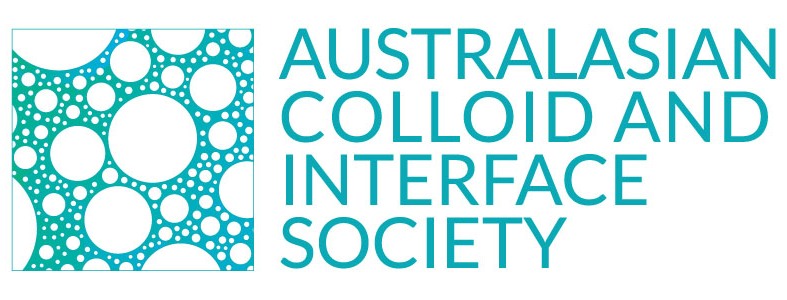Board member profiles
| Stuart Prescott, PresidentUNSW I am an Associate Professor at UNSW Chemical Engineering in Sydney, Australia. My research interests are in the relationships between the molecular structures that are found at interfaces and the control of properties at interfaces. I study surfactant structures, adsorbed polymers, biological systems, and polymer brushes to build the knowledge needed to engineer fluids and interfaces. I have also worked extensively on the development of new instrumentation for colloidal and interfacial systems, including neutron reflection sample environments for studying the effects of confinement on polymers and bench-top NMR instrumentation for surface area and surface chemistry monitoring. I joined UNSW Chemical Engineering in 2013, following an EU Marie Curie individual fellowship and lectureship at the University of Bristol UK, and a PhD at the University of Sydney/CSIRO. |
 | Marta Krasowska, Vice-PresidentUniSA I am a Professor in Physical Chemistry at the University of South Australia, and my research focuses on the interactions between soft and rigid interfaces as well as the physicochemical properties of such interfaces. I use a variety of techniques, including tensiometry, light and x-ray scattering, FTIR, XPS, AFM, interferometry, and high-speed videography to study how thin films are formed and what gives foams and emulsions their structure and function. I have been serving on ANSTO Australian Synchrotron User Advisory Committee (elected member, Deputy Chair, Chair) and ANSTO Australian Synchrotron IR and THz Program Advisory Committee. |
| Maggie Zhai, Honourary TreasurerRMIT University I’m a Senior Research Fellow within Applied Chemistry at RMIT University. I completed a PhD in 2012 at Monash University working at protein structural behaviour at oil-water interface using synchrotron radiation circular dichroism. I then worked 2.5 years at CSIRO as a Postdoc. My research interests focus on understanding amphiphile self-assembly, lamellar-inverse structural transition, development of self-assembled lipid nanocarriers for the delivery of therapeutics, and characterisation of nanoparticle-cell interactions. Recently, I’m particularly interested in applying synchrotron SAXS/bioSAXS to study the self-assembled structural dynamics of lipids upon RNA complexation and endosomal acidification. I am an ANSTO Australian Synchrotron User Advisory Committee (UAC) member since 2022. |
| Livia Salvati Manni, Equity and DiversityANSTO Australian Synchrotron I am a beamline scientist on the SAXS/WAXS beamline at the Australian Synchrotron. I am interested in design and characterisation of lipidic materials tailored to applications, and in lipid behaviour in extreme environments, for example non aqueous solvents and at extreme temperature. I employ x-ray and neutron scattering techniques to address fundamental and applied questions about lipidic self-assembly. Prior to working at the Australian Synchrotron, I worked as a postdoc at Monash University, the University of Sydney and ETH Zurich. |
| Saffron Bryant, Awards and PrizesRMIT University I am a researcher with a passion for bringing science 'to the real world', by finding applications for my work. I work at the intersection of chemistry, biology, and physics which I leverage to bring new perspectives to old problems. I completed my PhD at The University of Sydney before carrying out a postdoc position at The University of Bath. I then returned to Australia and took up a research position at RMIT University where I am exploring advanced materials for applications including cryopreservation, drug delivery, and wound healing. |
| Asaph Widmer-Cooper, CommunicationsThe University of Sydney I am an Associate Professor in the School of Chemistry at the University of Sydney and a member of the University of Sydney Nano Institute. My research focuses on the development and application of computational methods for understanding how nanomaterials form and behave. This includes work on the colloidal properties of nanoparticles, molecular and nanoparticle assembly, the structure and dynamics of complex fluids, crystal nucleation and growth, and the design of new materials for harnessing solar energy. I became an ARC Future Fellow at USyd in 2014, following a Visiting Fellowship at the ETH Zurich and a Postdoctoral Fellowship at the University of California, Berkeley. I have attended every ACIS Symposium since 2013 and co-chaired the Nanoparticle themes at the 2019 and 2024 meetings. |
| Nhiem Tran, MembershipRMIT University I am a Senior Lecturer in Applied Chemistry at RMIT University. My research interests lie in nanomedicine and the interfaces between biomaterials and biology. Recently, my focus has been on controlling the interaction between self-assembled lipid nanoparticles and cells to deliver bioactive compounds, including chemotherapeutic drugs, antimicrobial agents, and RNA. I am also interested in developing medical implant surfaces capable of altering cellular and bacterial responses. I earned a PhD degree in Physics from Brown University in the US in 2012. Following two years as a postdoc at a Trauma Research Centre in Rhode Island Hospital, I relocated to Australia to work on lipid self-assembly and their biomedical applications at CSIRO and Australian Synchrotron. I have been at RMIT since late 2015, initially as a Vice Chancellor’s Research Fellow and later as a Senior Lecturer. |
| Taniela LoloheaAuckland University of Technology I am a lecturer at Auckland University of Technology. My research is centralised around plasma systems particularly atmospheric aerosol assisted plasma jets, and radio-frequency pulsed plasma jets to produce unique and tailored coatings. My group is particularly interested in producing plasma deposited coatings using biomolecules such as peptides and how we can control their morphology whilst retaining functionality. I am interested in how the interface between plasma species and materials can influence the properties of unique surface coatings, which is simply where the interesting "magic" happens! Prior to my lecturing position at AUT, I completed my PhD at the University of Auckland followed by a postdoctoral fellowship there also. |








